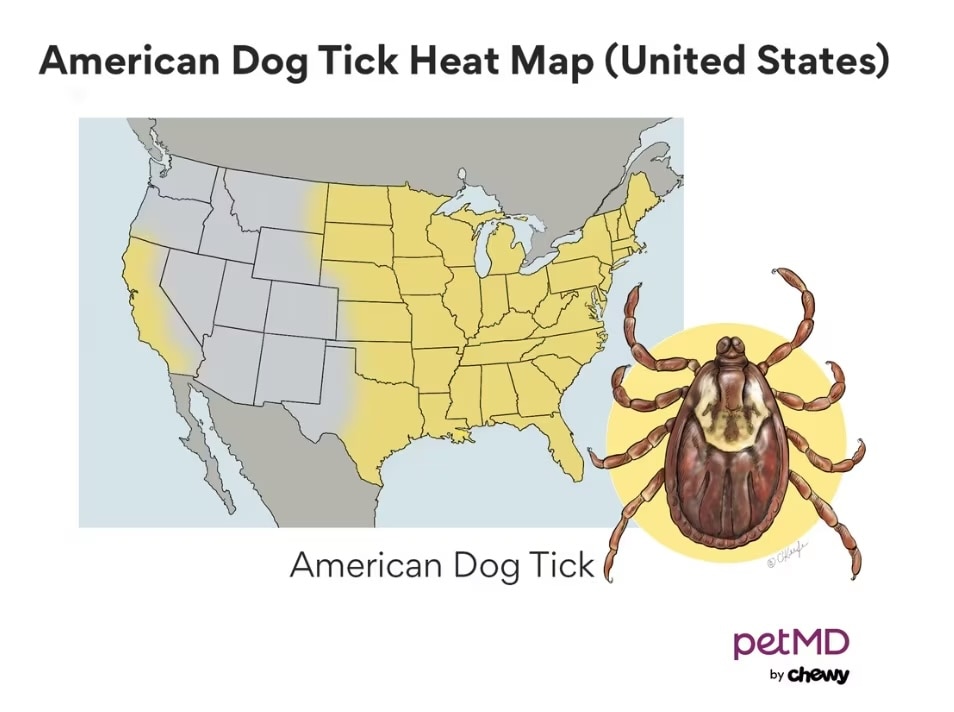Everything You Need To Know About the Wood Tick
ArtBoyMB/E+ via Getty Images
When it comes to protecting your pet, tick prevention is essential. Even pets that don’t spend much time outside are susceptible to ticks and the dangerous diseases they carry, because ticks can hitch a ride on you, your clothing, or other pets and end up inside your home.
While ticks, including the wood tick, are more commonly found in rural areas, they can adapt to other environments as well. The wood tick is common in the United States and causes major concern because of its ability to spread multiple diseases.
What Is a Wood Tick?
The wood tick, Dermacentor variabilis, also known as the American dog tick, can transmit several diseases to humans and pets.
Wood ticks are a type of hard tick, meaning their body has a hard exterior shell. Adult wood ticks have eight legs. Female ticks are slightly larger than males and vary in size from 3 to 15 millimeters in length, depending on whether they have recently ingested blood from a host.
Wood ticks can easily be differentiated from deer ticks, which are the cause of Lyme disease transmission. Wood ticks are larger than deer ticks and have a brown back with gray or silver markings and a brown scutum (the hard plate just behind the head). Deer ticks have a reddish-brown back with a black scutum.
The wood tick is a three-host tick, which means it needs a blood meal during each of its three life cycles. The life cycles of the wood tick are:
-
Larva: The six-legged larval tick feeds on small mammals such as mice, then falls off to digest its blood meal and morph into an eight-legged nymph.
-
Nymph: The nymph has eight legs and wide mouth parts, but it does not have a genital opening on its back end. The nymph will feed on a mammal larger than a mouse, such as a raccoon or opossum, then drop off to become an adult.
-
Adult: Like nymphs, adults have eight legs and wide mouth parts. Adult wood ticks feed on dogs, humans, and other large animals. Once the tick falls off and lays eggs it dies, completing its life cycle.
The wood tick’s complete life cycle takes approximately 54 days, but a female can take up to two years to lay eggs if conditions are suboptimal.
This delay can happen due to a process called overwintering. Overwintering is when the conditions are not perfect for the tick to keep reproducing. It will go dormant, often in the winter months, then continue its life cycle once the environment is warmer.
Where Do Wood Ticks Live?

Wood ticks are the most common type of tick in the United States and can be found anywhere east of the Rocky Mountains. They are most abundant in the eastern states from Massachusetts to Florida. But they are also common in the Midwest and Pacific Northwest. They can also be found in Canada and Mexico.
These ticks inhabit forest edges and areas with little to no tree coverage, as well as grassy fields, walkways, sidewalks, and nature trails. They prefer tall grass and low-lying bushes and twigs, so they can certainly be found in your yard, local dog park, and areas where you take daily walks.
Wood ticks prefer hot, humid environments and are most active in the spring and summer months. Ticks are generally inactive during the winter; however, they can become active on warm winter days. If an adult female doesn’t find a suitable host in the fall, she can survive the winter in a dormant state and then resume her search for a host the next spring.
All cats and dogs should receive year-round tick prevention and be checked for ticks after walking in areas where ticks are likely to be found.
Are Wood Ticks Dangerous?
Wood ticks are dangerous to people, dogs, livestock, and other animals because they can transmit several serious diseases while feeding. Wood ticks commonly carry and transmit Rocky Mountain spotted fever (Rickettsia rickettsii), tularemia (Francisella tularensis), and canine tick paralysis.
Who Do Wood Ticks Bite?
Adult wood ticks commonly feed on and potentially transmit diseases to humans, cats, dogs, and other larger mammals.
What To Do If Your Pet Is Bitten by a Wood Tick
If you see a wood tick on your pet, remove it immediately. Although wood ticks generally don’t transmit diseases unless they are attached for at least six to eight hours, the sooner you remove the tick, the less likely your beloved pet will be infected.
Wearing gloves, remove the entire tick with a special tick removal tool—including the small mouth parts that are embedded in the skin. After removing the tick, place it in a small container so you can bring—or describe—it to your veterinarian for identification. This will help your vet decide whether your pet needs testing for tick-borne diseases now and in the future.
Using an alcohol wipe or antiseptic, clean the bite wound to prevent infection. Monitor the bite site daily and watch your pet for signs of illness.
If you notice any of the following symptoms, take your pet to their vet right away:
-
Redness
-
Swelling or pain from the bite site
-
Fever
-
Lack of appetite
-
Lethargy
-
Other abnormal behavior
You can prevent tick bites and disease transmission by using year-round tick prevention, keeping the edges of your yard clean and trimmed, and frequently inspecting your pet for ticks.
